MA3-026
antibody from Invitrogen Antibodies
Targeting: TCP1
CCT1, Ccta, D6S230E
 Western blot
Western blot Immunocytochemistry
Immunocytochemistry Immunoprecipitation
Immunoprecipitation Immunohistochemistry
Immunohistochemistry Flow cytometry
Flow cytometry Other assay
Other assayAntibody data
- Antibody Data
- Antigen structure
- References [6]
- Comments [0]
- Validations
- Immunocytochemistry [5]
- Immunohistochemistry [2]
- Other assay [1]
Submit
Validation data
Reference
Comment
Report error
- Product number
- MA3-026 - Provider product page

- Provider
- Invitrogen Antibodies
- Product name
- TCP1 Monoclonal Antibody (91A)
- Antibody type
- Monoclonal
- Antigen
- Other
- Description
- MA3-026 detects T Complex Polypeptide 1 (TCP-1) from human, canine, chicken, hamster, mouse, primate, rat and yeast samples. MA3-026 has been successfully used in Western blot, immunofluorescence and immunoprecipitation procedures. By Western blot, this clone detects a ~57 kDa band representing TCP-1 in mouse 3T3 cells. Immunofluorescence staining of TCP-1 in mouse germ line cells with MA3-026 results in diffuse cytoplasmic staining. The MA3-026 immunizing peptide corresponds to amino acid residues 306-556 from mouse TCP-1. The epitope for this antibody has been mapped to amino acids 465-469 representing the pentamer peptide AKLRA.
- Reactivity
- Human, Mouse, Rat, Canine, Chicken/Avian, Hamster, Yeast
- Host
- Rat
- Isotype
- IgG
- Antibody clone number
- 91A
- Vial size
- 100 μL
- Concentration
- Conc. Not Determined
- Storage
- -20°C, Avoid Freeze/Thaw Cycles
Submitted references β-catenin links cell seeding density to global gene expression during mouse embryonic stem cell differentiation.
Direct control of lysosomal catabolic activity by mTORC1 through regulation of V-ATPase assembly.
Differential HDAC1/2 network analysis reveals a role for prefoldin/CCT in HDAC1/2 complex assembly.
Identification of six Tcp-1-related genes encoding divergent subunits of the TCP-1-containing chaperonin.
Identification of six Tcp-1-related genes encoding divergent subunits of the TCP-1-containing chaperonin.
The t complex polypeptide 1 (TCP-1) is associated with the cytoplasmic aspect of Golgi membranes.
LeBlanc L, Kim M, Kambhampati A, Son AJ, Ramirez N, Kim J
iScience 2022 Jan 21;25(1):103541
iScience 2022 Jan 21;25(1):103541
Direct control of lysosomal catabolic activity by mTORC1 through regulation of V-ATPase assembly.
Ratto E, Chowdhury SR, Siefert NS, Schneider M, Wittmann M, Helm D, Palm W
Nature communications 2022 Aug 17;13(1):4848
Nature communications 2022 Aug 17;13(1):4848
Differential HDAC1/2 network analysis reveals a role for prefoldin/CCT in HDAC1/2 complex assembly.
Banks CAS, Miah S, Adams MK, Eubanks CG, Thornton JL, Florens L, Washburn MP
Scientific reports 2018 Sep 12;8(1):13712
Scientific reports 2018 Sep 12;8(1):13712
Identification of six Tcp-1-related genes encoding divergent subunits of the TCP-1-containing chaperonin.
Kubota H, Hynes G, Carne A, Ashworth A, Willison K
Current biology : CB 1994 Feb 1;4(2):89-99
Current biology : CB 1994 Feb 1;4(2):89-99
Identification of six Tcp-1-related genes encoding divergent subunits of the TCP-1-containing chaperonin.
Kubota H, Hynes G, Carne A, Ashworth A, Willison K
Current biology : CB 1994 Feb 1;4(2):89-99
Current biology : CB 1994 Feb 1;4(2):89-99
The t complex polypeptide 1 (TCP-1) is associated with the cytoplasmic aspect of Golgi membranes.
Willison K, Lewis V, Zuckerman KS, Cordell J, Dean C, Miller K, Lyon MF, Marsh M
Cell 1989 May 19;57(4):621-32
Cell 1989 May 19;57(4):621-32
No comments: Submit comment
Supportive validation
- Submitted by
- Invitrogen Antibodies (provider)
- Main image
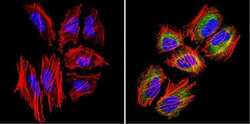
- Experimental details
- Immunofluorescent analysis of TCP1 (green) in Hela cells. Formalin-fixed cells were permeabilized with 0.1% Triton X-100 in TBS for 5-10 minutes at room temperature and blocked with 3% BSA-PBS for 30 minutes at room temperature. Cells were probed with a TCP1 Monclonal Antibody (91A) (Product # MA3-026) at a dilution of 1:100 and incubated overnight in a humidified chamber. Cells were washed with PBST and incubated with a DyLight-conjugated secondary antibody for 45 minutes at room temperature in the dark. F-actin (red) was stained with a fluorescent phalloidin and nuclei (blue) were stained with DAPI. Images were taken at a 60X magnification.
- Submitted by
- Invitrogen Antibodies (provider)
- Main image
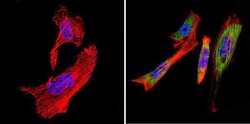
- Experimental details
- Immunofluorescent analysis of TCP1 (green) in murine cells. Formalin-fixed cells were permeabilized with 0.1% Triton X-100 in TBS for 5-10 minutes at room temperature and blocked with 3% BSA-PBS for 30 minutes at room temperature. Cells were probed with a TCP1 Monclonal Antibody (91A) (Product # MA3-026) at a dilution of 1:100 and incubated overnight in a humidified chamber. Cells were washed with PBST and incubated with a DyLight-conjugated secondary antibody for 45 minutes at room temperature in the dark. F-actin (red) was stained with a fluorescent phalloidin and nuclei (blue) were stained with DAPI. Images were taken at a 60X magnification.
- Submitted by
- Invitrogen Antibodies (provider)
- Main image
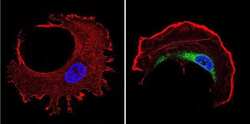
- Experimental details
- Immunofluorescent analysis of TCP1 (green) in human cells. Formalin-fixed cells were permeabilized with 0.1% Triton X-100 in TBS for 5-10 minutes at room temperature and blocked with 3% BSA-PBS for 30 minutes at room temperature. Cells were probed with a TCP1 Monclonal Antibody (91A) (Product # MA3-026) at a dilution of 1:100 and incubated overnight in a humidified chamber. Cells were washed with PBST and incubated with a DyLight-conjugated secondary antibody for 45 minutes at room temperature in the dark. F-actin (red) was stained with a fluorescent phalloidin and nuclei (blue) were stained with DAPI. Images were taken at a 60X magnification.
- Submitted by
- Invitrogen Antibodies (provider)
- Main image
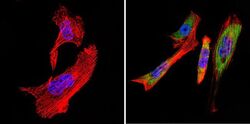
- Experimental details
- Immunofluorescent analysis of TCP1 (green) in murine cells. Formalin-fixed cells were permeabilized with 0.1% Triton X-100 in TBS for 5-10 minutes at room temperature and blocked with 3% BSA-PBS for 30 minutes at room temperature. Cells were probed with a TCP1 Monclonal Antibody (91A) (Product # MA3-026) at a dilution of 1:100 and incubated overnight in a humidified chamber. Cells were washed with PBST and incubated with a DyLight-conjugated secondary antibody for 45 minutes at room temperature in the dark. F-actin (red) was stained with a fluorescent phalloidin and nuclei (blue) were stained with DAPI. Images were taken at a 60X magnification.
- Submitted by
- Invitrogen Antibodies (provider)
- Main image
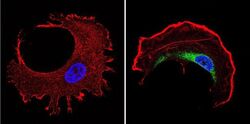
- Experimental details
- Immunofluorescent analysis of TCP1 (green) in human cells. Formalin-fixed cells were permeabilized with 0.1% Triton X-100 in TBS for 5-10 minutes at room temperature and blocked with 3% BSA-PBS for 30 minutes at room temperature. Cells were probed with a TCP1 Monclonal Antibody (91A) (Product # MA3-026) at a dilution of 1:100 and incubated overnight in a humidified chamber. Cells were washed with PBST and incubated with a DyLight-conjugated secondary antibody for 45 minutes at room temperature in the dark. F-actin (red) was stained with a fluorescent phalloidin and nuclei (blue) were stained with DAPI. Images were taken at a 60X magnification.
Supportive validation
- Submitted by
- Invitrogen Antibodies (provider)
- Main image
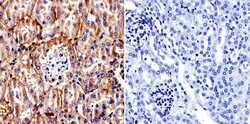
- Experimental details
- Immunohistochemistry was performed on normal biopsies of deparaffinized mouse kidney tissue. To expose target proteins, heat induced antigen retrieval was performed using 10mM sodium citrate (pH6.0) buffer, microwaved for 8-15 minutes. Following antigen retrieval tissues were blocked in 3% BSA-PBS for 30 minutes at room temperature. Tissues were then probed at a dilution of 1:20 with a Rat Monoclonal Antibody recognizing TCP1 (Product # MA3-026) or without primary antibody (negative control) overnight at 4°C in a humidified chamber. Tissues were washed extensively with PBST and endogenous peroxidase activity was quenched with a peroxidase suppressor. Detection was performed using a biotin-conjugated secondary antibody and SA-HRP, followed by colorimetric detection using DAB. Tissues were counterstained with hematoxylin and prepped for mounting.
- Submitted by
- Invitrogen Antibodies (provider)
- Main image
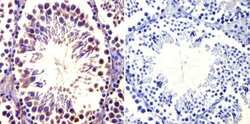
- Experimental details
- Immunohistochemistry was performed on normal biopsies of deparaffinized mouse testis tissue. To expose target proteins, heat induced antigen retrieval was performed using 10mM sodium citrate (pH6.0) buffer, microwaved for 8-15 minutes. Following antigen retrieval tissues were blocked in 3% BSA-PBS for 30 minutes at room temperature. Tissues were then probed at a dilution of 1:20 with a Rat Monoclonal Antibody recognizing TCP1 (Product # MA3-026) or without primary antibody (negative control) overnight at 4°C in a humidified chamber. Tissues were washed extensively with PBST and endogenous peroxidase activity was quenched with a peroxidase suppressor. Detection was performed using a biotin-conjugated secondary antibody and SA-HRP, followed by colorimetric detection using DAB. Tissues were counterstained with hematoxylin and prepped for mounting.
Supportive validation
- Submitted by
- Invitrogen Antibodies (provider)
- Main image
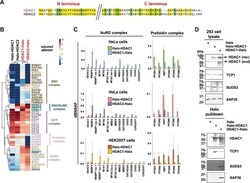
- Experimental details
- Figure 3 HDAC2 (HeLa) or HDAC1 (HEK293T) associations with Sin3, NuRD, CCT and prefoldin complexes depends on affinity tag location. ( A ) Sequence alignment of the N and C termini of human HDAC1 (NP_004955) and human HDAC2 (NP_001518), using the AlignX tool in Vector NTI 64 . Identical residues are highlighted in yellow and similar residues in green. ( B ) Hierarchical clustering of Halo-tagged HDAC1 and HDAC2 associated complexes. Bait normalized dNSAF values (Supplementary Tables S3 and S4 ) were scaled 1000x prior to clustering using R. Values were further adjusted using a log 2 transformation for representation using the indicated colour scale. Dissimilarity matrix calculations were based on Euclidean distance. ( C ) Components of the NuRD or prefoldin complexes copurifying with tagged versions of either HDAC1 (HeLa cells), HDAC2 (HeLa cells) or with HDAC1 (HEK293T cells). Error bars indicate standard deviation. ( D ) Lysates from HEK293T cells transfected with constructs expressing either Halo tag alone, Halo-HDAC1 or HDAC1-Halo were processed as described in ""Methods"". Halo purified samples were analysed using SDS-PAGE and visualised by Western blotting using antibodies to the proteins indicated. Bands corresponding to recombinant Halo-tagged HDAC1 (HDAC1(rec)) or endogenous HDAC1 (HDAC1(end)) in the lysate samples are marked. Full length images of Western blots are presented in Supplementary Figure 2.
 Explore
Explore Validate
Validate Learn
Learn